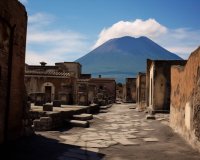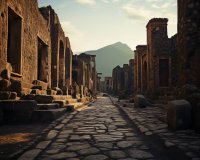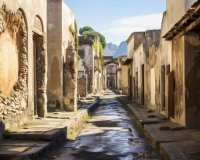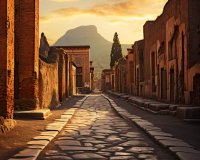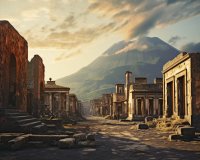Pompeii and Vesuvius: A Comprehensive Guide
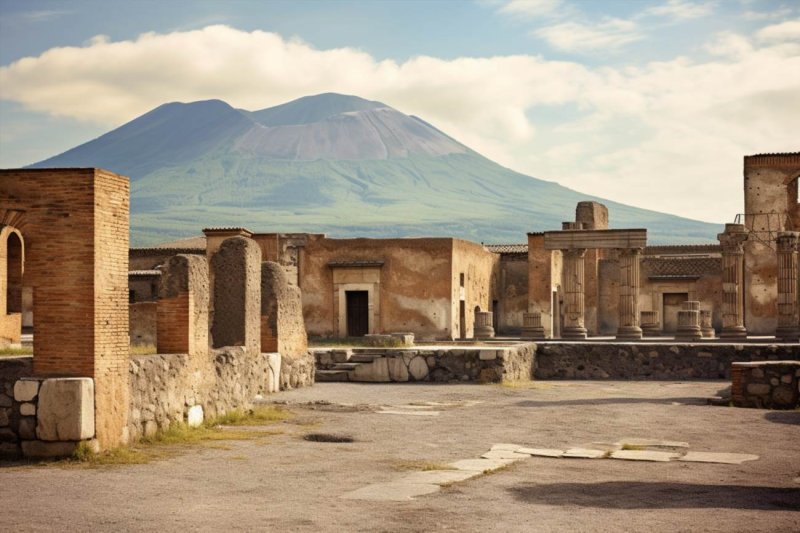
The Fascinating History of Pompeii and the Eruption of Mount Vesuvius
Pompeii, a city frozen in time, and Mount Vesuvius, the volcano that buried it, are two names forever intertwined in history. The story of Pompeii and the catastrophic eruption of Vesuvius in 79 AD is a tale of tragedy and discovery that has captured the imagination of people for centuries.
The Rise of Pompeii
Pompeii was an ancient Roman city located in the Campania region of Italy, near the Bay of Naples. Founded in the 6th century BC, it thrived as a bustling commercial and resort center, thanks to its prime location along the Mediterranean coast. The city boasted impressive architecture, vibrant markets, and a thriving population.
One of the remarkable aspects of Pompeii is its well-preserved state. The city was buried under layers of volcanic ash and pumice when Mount Vesuvius erupted in 79 AD. This tragic event, while catastrophic for the inhabitants, would ultimately serve as a time capsule of ancient Roman life for future generations.
The Eruption of Mount Vesuvius
Mount Vesuvius, a volcano just a few miles from Pompeii, had been dormant for centuries leading up to the eruption. The eruption began on August 24, 79 AD, and it's said to have released a cloud of ash, pumice, and gas that reached a height of 20.5 miles. The sky darkened, and molten rock and ash rained down on Pompeii and the surrounding areas.
The eruption was devastating. The intense heat, ash, and pyroclastic surges buried Pompeii, Herculaneum, and several other nearby towns under layers of volcanic debris. Thousands of people were killed, and the landscape was forever transformed.
Rediscovery and Excavation
Pompeii was largely forgotten in the centuries that followed, its location buried and obscured. It wasn't until the 18th century that Pompeii was rediscovered by accident during the construction of a new aqueduct. The initial excavation efforts revealed an astonishingly well-preserved city beneath the layers of volcanic material.
Archaeological exploration of Pompeii began in earnest, and the site has since yielded a treasure trove of information about daily life in ancient Rome. The city's buildings, artwork, and even the casts of its inhabitants who perished during the eruption have provided invaluable insights into the past.
Key Discoveries in Pompeii
Pompeii has revealed a wealth of information about ancient Roman life. Some of the key discoveries include:
- Frescoes: The city is adorned with stunning frescoes that depict scenes of everyday life, mythology, and architecture of the time.
- Amphitheater: Pompeii's amphitheater, one of the oldest surviving examples, showcases the importance of entertainment in Roman society.
- Forum: The heart of the city, where commerce and politics converged, has provided insights into the governance and social structure of Pompeii.
- Residences: Lavish homes, like the House of the Vettii, offer a glimpse into the lives of the wealthy and their artistic tastes.
- Victims' Casts: The casts of human bodies and animals trapped in the ash have provided poignant snapshots of the final moments of Pompeii's inhabitants.
Preservation and Tourism
Pompeii and its neighboring sites, including Herculaneum and Oplontis, have been designated as UNESCO World Heritage Sites. Efforts have been made to preserve and protect these remarkable archaeological treasures for future generations.
Today, Pompeii is one of Italy's most popular tourist destinations. Visitors from around the world come to explore the ancient streets, marvel at the beautifully preserved buildings, and gain a deeper understanding of life in the Roman Empire.
Conclusion
Pompeii and the eruption of Mount Vesuvius are a testament to the power and unpredictability of nature. While the tragedy of 79 AD left a scar on history, it also gave us a unique window into the past. The ongoing excavation and research at Pompeii continue to shed light on the lives of the people who once walked its streets, making it an essential destination for anyone interested in history, archaeology, and the enduring allure of the ancient world.
Explore Pompeii at Your Own Pace
Discover the ancient ruins of Pompeii with a day trip from Naples provided by Napoli Official Tour. Board a comfortable shuttle bus at Piazza del Gesù Nuovo in Naples, and enjoy a hassle-free journey to the archaeological site. Benefit from priority entrance upon arrival, saving valuable time to immerse yourself in the wonders of Pompeii.
Travel back in time over 2,000 years as you wander through cobblestone streets, envisioning life during the Roman Empire. Marvel at the well-preserved remains of public baths, villas, and temples buried by the eruption of Mount Vesuvius in 79 AD. Explore the mosaic-adorned luxury villas of prosperous merchants and witness the intriguing sites, including the House of the Faun, a brothel, and public baths.
With transportation by shuttle bus and priority access to the ruins, this day trip ensures a seamless and efficient experience. While the tour does not include a guide, it offers the flexibility to explore Pompeii at your own pace, making it ideal for independent travelers.
Customer Reviews
Overall Rating: 4.3/5 based on 11 reviews
Guide: 5/5
Transportation: 5/5
Service: 4.7/5
Organization: 4.7/5
The History of Pompeii
Pompeii is an ancient Roman city located near modern Naples in Italy. The history of Pompeii is a fascinating tale of a bustling city that met a tragic end. This article delves into the rich history of Pompeii, from its establishment to its rediscovery in modern times.
Founding and Early History
Pompeii was founded in the 6th century BC by the Oscans, an ancient Italic people. It was later influenced by the Greeks and then absorbed into the Roman Republic in the 4th century BC. The city thrived as a Roman colony, becoming an important trading center due to its strategic location near the Bay of Naples.
Life in Pompeii
Pompeii was a bustling city with a population estimated to be around 11,000 people. The city boasted impressive architecture, including temples, villas, and an amphitheater. The residents enjoyed a comfortable lifestyle, with many engaging in trade, agriculture, and craftsmanship.
The city had a complex social structure, with the elite class living in grand villas, while the commoners resided in smaller homes. Pompeii also had a thriving cultural scene, with theaters and public baths for leisure and entertainment.
The Eruption of Mount Vesuvius
In 79 AD, disaster struck Pompeii in the form of the catastrophic eruption of Mount Vesuvius. The eruption buried the city under a thick layer of volcanic ash and pumice, preserving it like a time capsule. Thousands of residents perished in the disaster, and the city was abandoned and forgotten for centuries.
Rediscovery and Excavation
Pompeii remained buried and largely forgotten until the 16th century when it was accidentally rediscovered during the construction of an aqueduct. However, it wasn't until the 18th century that large-scale excavations began. The city's excavation has provided invaluable insights into ancient Roman life, architecture, and art.
The excavations at Pompeii have unearthed remarkably well-preserved buildings, artifacts, and even plaster casts of the unfortunate victims who perished in the eruption. These casts offer a haunting glimpse into the final moments of the city's residents.
Pompeii Today
Today, Pompeii is a UNESCO World Heritage Site and one of the most visited archaeological sites in the world. The site has been meticulously preserved and offers a unique opportunity to walk through the streets of an ancient Roman city frozen in time. Visitors can explore the ruins of houses, temples, and public buildings, gaining a deeper understanding of daily life in antiquity.
While Pompeii's tragic history is a reminder of the destructive power of natural disasters, it also stands as a testament to the resilience of historical artifacts and the dedication of archaeologists and preservationists who have worked to uncover and protect this ancient treasure.
Conclusion
The history of Pompeii is a story of rise, tragedy, and rediscovery. This ancient Roman city, frozen in time by the eruption of Mount Vesuvius, continues to captivate and educate people from around the world. Pompeii stands as a testament to the enduring importance of preserving our cultural heritage and the insights it can offer into the past.
Step Back in Time: Pompeii Guided Tour from Naples
Embark on a fascinating journey to ancient Rome with our Pompeii guided walking tour, complete with skip-the-line tickets for seamless entry. Delve into the rich history and architecture of this Roman city with the guidance of our knowledgeable tour leader.
Experience the privilege of skipping the line, entering through a separate entrance, and immersing yourself in the wonders of one of Europe's most significant archaeological sites. Wander through the ancient streets, gaining insights into the daily lives of Pompeii's inhabitants before the catastrophic eruption of Vesuvius in 79 AD.
Discover the structures vital to Roman civic life, including the Basilica, Forum, thermal baths, and Theater. Explore commercial and residential neighborhoods, catching glimpses of a bakery and typical housing blocks that have stood the test of time.
Your adventure includes a 2-hour small group guided tour of Pompeii, offering a comprehensive exploration of this ancient marvel. Enjoy the convenience of a free transfer provided by Your Travel Break in an air-conditioned minivan, ensuring a comfortable journey from Naples.
Join us on this unforgettable journey through history, where each step reveals the secrets of Pompeii's past.
Highlights:
- Skip the line entrance
- Small group experience
- Pick-up and drop-off in Naples
Don't miss out on this extraordinary exploration of Pompeii's archaeological wonders!
Customer Reviews
Overall Rating: 4.7/5 based on 23 reviews
Transportation: 4.7/5
Value for Money: 4.7/5
Read what our travelers have to say:
"Perfect excursion! Our guide Francesco is great, he told a lot of stories not only about some historical facts but about day-to-day life in Pompeii, that was really interesting."
Denis – Russia
"Julia has been our guide and she was amazing! Very sweet, very kind and explained everything with a lot of details, we could feel her passion when explaining!"
Raquel – Spain
"The tour was very good. Guide was great. The only problem was the directions to get to the starting point were very unclear. It gave us no information about the meeting location except an address."
Clay – United States
Book your spot now and step into the captivating world of Pompeii!
The Activity of Vesuvius and the Tragic Fate of Pompeii
Vesuvius, one of the most famous volcanoes in the world, has a long history of volcanic activity that has left a significant mark on the city of Pompeii and the surrounding areas. This article will explore the history of Vesuvius's eruptions, their impact on Pompeii, and the ongoing scientific efforts to monitor and understand this active volcano.
The Geological History of Vesuvius
Vesuvius is located on the western coast of Italy, near the city of Naples. It is part of the Campanian volcanic arc, which includes several other volcanoes. The history of Vesuvius's eruptions dates back thousands of years, with its first well-documented eruption occurring in 79 AD.
One of the most famous eruptions of Vesuvius was the eruption in 79 AD when it buried the ancient Roman city of Pompeii and the nearby town of Herculaneum under a thick layer of volcanic ash and pyroclastic material. The catastrophic event preserved these cities in remarkable detail, providing invaluable insights into daily life in ancient Rome.
The Destruction of Pompeii
The eruption of 79 AD was a cataclysmic event. Vesuvius spewed a towering column of ash, pumice, and volcanic gases into the sky, followed by pyroclastic surges that engulfed Pompeii and its residents. The intense heat and ashfall trapped and ultimately suffocated many of the city's inhabitants.
Due to the suddenness of the eruption, the city and its people were frozen in time, leaving behind haunting plaster casts of the victims in their final moments of agony. Pompeii remained buried for centuries until its rediscovery in the 18th century, and it has since become one of the world's most significant archaeological sites.
Subsequent Eruptions and Scientific Study
Vesuvius has remained active over the centuries, with many eruptions recorded throughout history. Notable eruptions occurred in 1631, 1944, and 1944. The eruption of 1631 was particularly devastating, causing widespread destruction and loss of life.
Today, Vesuvius continues to be closely monitored by Italian scientists. The Vesuvius Observatory, founded in 1841, plays a vital role in studying the volcano's behavior and predicting potential eruptions. These efforts aim to safeguard the lives of the approximately three million people living in the vicinity of the volcano.
Conclusion
The activity of Vesuvius, as witnessed through its eruptions, holds a unique place in history. The tragic fate of Pompeii serves as a poignant reminder of the destructive power of volcanic eruptions. As scientists continue to study and monitor Vesuvius, we gain a better understanding of the complex dynamics of this volcano and, in turn, work to protect the lives and heritage of the region.



